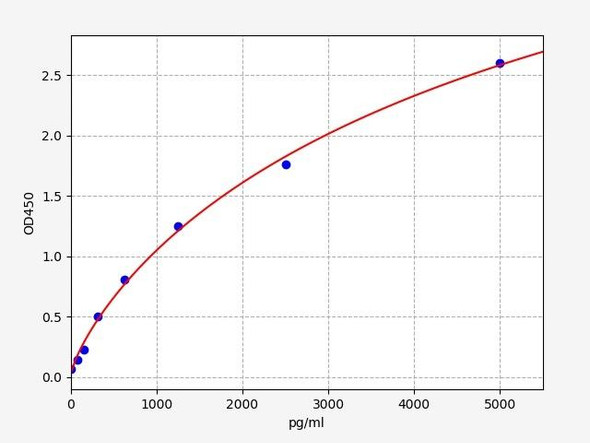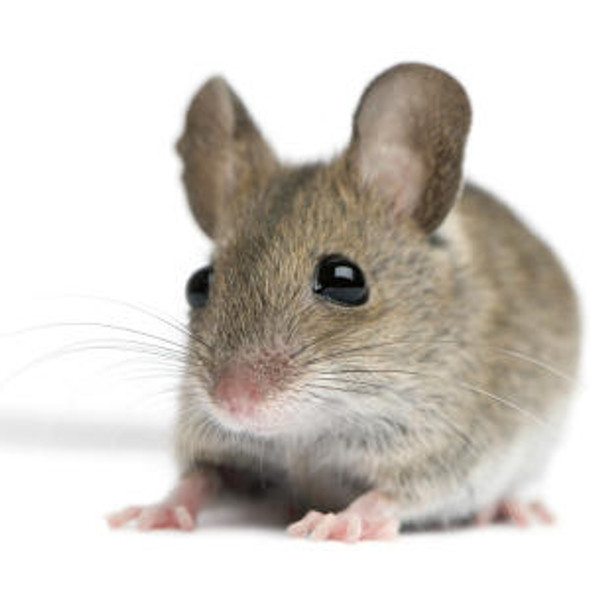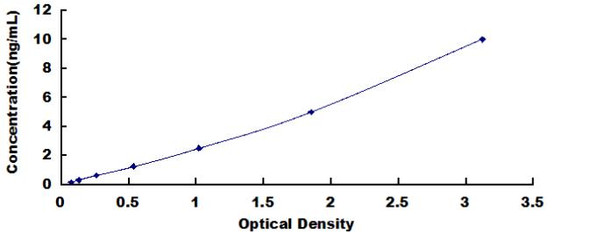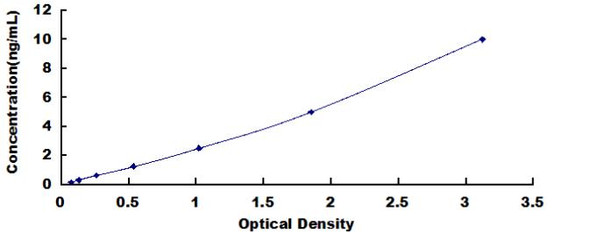Mouse Cell Biology ELISA Kits 1
Mouse MUC1 (Mucin 1) ELISA Kit (MOES01746)
- SKU:
- MOES01746
- Product Type:
- ELISA Kit
- Size:
- 96 Assays
- Uniprot:
- Q02496
- Sensitivity:
- 0.09ng/mL
- Range:
- 0.16-10ng/mL
- ELISA Type:
- Sandwich
- Reactivity:
- Mouse
- Sample Type:
- Serum, plasma and other biological fluids
Description
| Assay type: | Sandwich |
| Format: | 96T |
| Assay time: | 4.5h |
| Reactivity: | Mouse |
| Detection Method: | Colormetric |
| Detection Range: | 0.16-10 ng/mL |
| Sensitivity: | 0.10 ng/mL |
| Sample Volume Required Per Well: | 100µL |
| Sample Type: | Serum, plasma and other biological fluids |
| Specificity: | This kit recognizes Mouse MUC1 in samples. No significant cross-reactivity or interference between Mouse MUC1 and analogues was observed. |
This ELISA kit uses Sandwich-ELISA as the method. The micro ELISA plate provided in this kit has been pre-coated with an antibody specific to Mouse MUC1. Standards or samples are added to the appropriate micro ELISA plate wells and combined with the specific antibody. Then a biotinylated detection antibody specific for Mouse MUC1 and Avidin-Horseradish Peroxidase (HRP) conjugate are added to each micro plate well successively and incubated. Free components are washed away. The substrate solution is added to each well. Only those wells that contain Mouse MUC1, biotinylated detection antibody and Avidin-HRP conjugate will appear blue in color. The enzyme-substrate reaction is terminated by adding Stop Solution and the color turns yellow. The optical density (OD) is measured spectrophotometrically at a wavelength of 450 nm ± 2 nm. The OD value is proportional to the concentration of Mouse MUC1. The concentration of Mouse MUC1 in samples can be calculated by comparing the OD of the samples to the standard curve.
| UniProt Protein Function: | MUC1: a large cell surface glycoprotein expressed by most glandular and ductal epithelial cells and some hematopoietic cell lineages. Plays a role in adhesion and cell-cell interactions, metastasis and signaling. May provide a protective layer on epithelial surfaces. Direct or indirect interaction with actin cytoskeleton. Its cytoplasmic tail (MUC1CT) is involved in several signaling pathways, including those involving Ras, beta-catenin, p120 catenin, p53 and estrogen receptor alpha. MUC1CT also forms complexes with transcription factors, and then translocates to the nucleus by an unknown mechanism, where it is believed to influence the transcription of their target genes. MUC1CT has also been proposed to localize to mitochondrial membranes under conditions of genotoxic stress, where it attenuates the apoptotic pathway in response and confers resistance to apoptosis-inducing drugs. Aberrantly glycosylated forms expressed in human epithelial tumors, such as breast or ovarian cancer and also in non-epithelial tumor cells. Nine alternatively spliced isoforms have been described. Isoforms 5 and 9 are secreted. Isoform 7, expressed only in tumor cells, is a receptor and binds the secreted isoform 5. The binding induces the phosphorylation of the isoform 7, alters cellular morphology and initiates cell signaling. Can bind to GRB2 adapter protein. |
| UniProt Protein Details: | Protein type:Membrane protein, integral; Actin-binding; Cell adhesion; Nuclear receptor co-regulator; Tumor suppressor; Motility/polarity/chemotaxis Cellular Component: cell surface; membrane; cytoplasm; apical plasma membrane; integral to membrane; plasma membrane; nucleus |
| UniProt Code: | Q02496 |
| NCBI GenInfo Identifier: | 166898018 |
| NCBI Gene ID: | 17829 |
| NCBI Accession: | Q02496. 2 |
| UniProt Related Accession: | Q02496 |
| Molecular Weight: | 64,539 Da |
| NCBI Full Name: | Mucin-1 |
| NCBI Synonym Full Names: | mucin 1, transmembrane |
| NCBI Official Symbol: | Muc1 |
| NCBI Official Synonym Symbols: | EMA; CD227; Muc-1 |
| NCBI Protein Information: | mucin-1; episialin |
| UniProt Protein Name: | Mucin-1 |
| UniProt Synonym Protein Names: | Episialin; CD_antigen: CD227Cleaved into the following 2 chains:Mucin-1 subunit alpha; MUC1-NT; MUC1-alpha; Mucin-1 subunit beta; MUC1-betaAlternative name(s):MUC1-CT |
| Protein Family: | Mucin |
| UniProt Gene Name: | Muc1 |
| UniProt Entry Name: | MUC1_MOUSE |
As the OD values of the standard curve may vary according to the conditions of the actual assay performance (e. g. operator, pipetting technique, washing technique or temperature effects), the operator should establish a standard curve for each test. Typical standard curve and data is provided below for reference only.
| Concentration (ng/mL) | O.D | Average | Corrected |
| 10 | 2.381 2.419 | 2.4 | 2.339 |
| 5 | 1.755 1.795 | 1.775 | 1.714 |
| 2.5 | 1.04 1.012 | 1.026 | 0.965 |
| 1.25 | 0.533 0.541 | 0.537 | 0.476 |
| 0.63 | 0.265 0.257 | 0.261 | 0.2 |
| 0.32 | 0.174 0.17 | 0.172 | 0.111 |
| 0.16 | 0.116 0.118 | 0.117 | 0.056 |
| 0 | 0.056 0.066 | 0.061 | -- |
Precision
Intra-assay Precision (Precision within an assay): 3 samples with low, mid range and high level Mouse MUC1 were tested 20 times on one plate, respectively.
Inter-assay Precision (Precision between assays): 3 samples with low, mid range and high level Mouse MUC1 were tested on 3 different plates, 20 replicates in each plate.
| Intra-assay Precision | Inter-assay Precision | |||||
| Sample | 1 | 2 | 3 | 1 | 2 | 3 |
| n | 20 | 20 | 20 | 20 | 20 | 20 |
| Mean (ng/mL) | 0.49 | 0.89 | 4.96 | 0.53 | 0.87 | 4.99 |
| Standard deviation | 0.03 | 0.04 | 0.22 | 0.03 | 0.05 | 0.25 |
| C V (%) | 6.12 | 4.49 | 4.44 | 5.66 | 5.75 | 5.01 |
Recovery
The recovery of Mouse MUC1 spiked at three different levels in samples throughout the range of the assay was evaluated in various matrices.
| Sample Type | Range (%) | Average Recovery (%) |
| Serum (n=5) | 88-101 | 93 |
| EDTA plasma (n=5) | 90-100 | 95 |
| Cell culture media (n=5) | 84-98 | 91 |
Linearity
Samples were spiked with high concentrations of Mouse MUC1 and diluted with Reference Standard & Sample Diluent to produce samples with values within the range of the assay.
| Serum (n=5) | EDTA plasma (n=5) | Cell culture media (n=5) | ||
| 1:2 | Range (%) | 87-102 | 89-103 | 90-103 |
| Average (%) | 93 | 94 | 95 | |
| 1:4 | Range (%) | 93-109 | 80-94 | 86-102 |
| Average (%) | 99 | 86 | 93 | |
| 1:8 | Range (%) | 88-100 | 85-99 | 83-96 |
| Average (%) | 93 | 92 | 89 | |
| 1:16 | Range (%) | 87-102 | 81-92 | 87-98 |
| Average (%) | 93 | 87 | 93 |
An unopened kit can be stored at 4°C for 1 month. If the kit is not used within 1 month, store the items separately according to the following conditions once the kit is received.
| Item | Specifications | Storage |
| Micro ELISA Plate(Dismountable) | 8 wells ×12 strips | -20°C, 6 months |
| Reference Standard | 2 vials | |
| Concentrated Biotinylated Detection Ab (100×) | 1 vial, 120 µL | |
| Concentrated HRP Conjugate (100×) | 1 vial, 120 µL | -20°C(shading light), 6 months |
| Reference Standard & Sample Diluent | 1 vial, 20 mL | 4°C, 6 months |
| Biotinylated Detection Ab Diluent | 1 vial, 14 mL | |
| HRP Conjugate Diluent | 1 vial, 14 mL | |
| Concentrated Wash Buffer (25×) | 1 vial, 30 mL | |
| Substrate Reagent | 1 vial, 10 mL | 4°C(shading light) |
| Stop Solution | 1 vial, 10 mL | 4°C |
| Plate Sealer | 5 pieces | |
| Product Description | 1 copy | |
| Certificate of Analysis | 1 copy |
- Set standard, test sample and control (zero) wells on the pre-coated plate and record theirpositions. It is recommended to measure each standard and sample in duplicate. Note: addall solutions to the bottom of the plate wells while avoiding contact with the well walls. Ensuresolutions do not foam when adding to the wells.
- Aliquot 100µl of standard solutions into the standard wells.
- Add 100µl of Sample / Standard dilution buffer into the control (zero) well.
- Add 100µl of properly diluted sample (serum, plasma, tissue homogenates and otherbiological fluids) into test sample wells.
- Cover the plate with the sealer provided in the kit and incubate for 90 min at 37°C.
- Aspirate the liquid from each well, do not wash. Immediately add 100µL of BiotinylatedDetection Ab working solution to each well. Cover the plate with a plate seal and gently mix. Incubate for 1 hour at 37°C.
- Aspirate or decant the solution from the plate and add 350µL of wash buffer to each welland incubate for 1-2 minutes at room temperature. Aspirate the solution from each well andclap the plate on absorbent filter paper to dry. Repeat this process 3 times. Note: a microplatewasher can be used in this step and other wash steps.
- Add 100µL of HRP Conjugate working solution to each well. Cover with a plate seal andincubate for 30 min at 37°C.
- Aspirate or decant the solution from each well. Repeat the wash process for five times asconducted in step 7.
- Add 90µL of Substrate Reagent to each well. Cover with a new plate seal and incubate forapproximately 15 min at 37°C. Protect the plate from light. Note: the reaction time can beshortened or extended according to the actual color change, but not by more than 30min.
- Add 50 µL of Stop Solution to each well. Note: Adding the stop solution should be done inthe same order as the substrate solution.
- Determine the optical density (OD value) of each well immediately with a microplate readerset at 450 nm.






